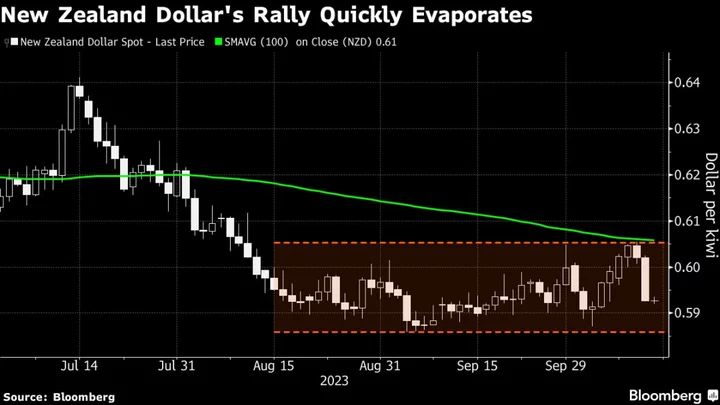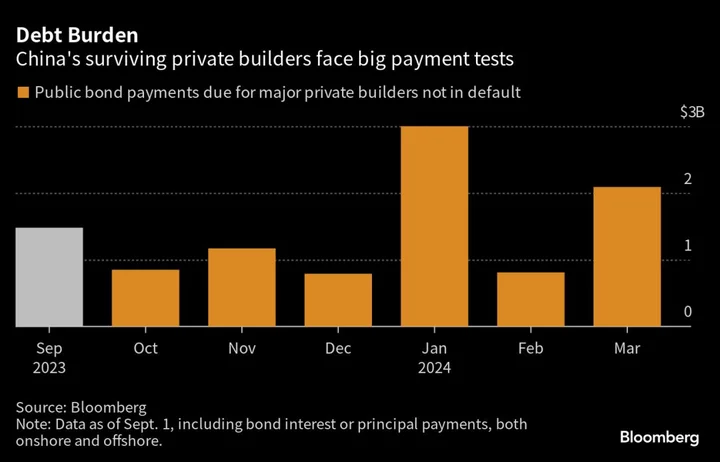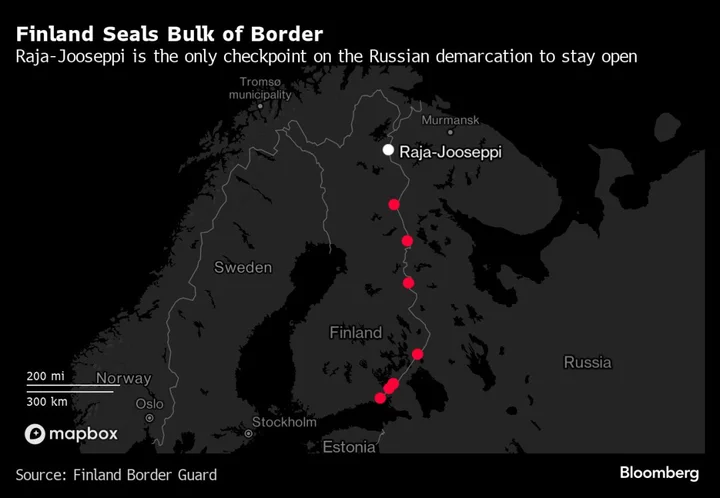The New Zealand dollar’s attempts at a rally are proving futile ahead of a report that’s expected to show inflation easing further, setting up the currency to end the year lower.
The kiwi rallied to a two-month high against the greenback last week before its subsequent fall after resistance around its 100-day moving average held. That may leave the currency vulnerable to further declines as investors reassess the Reserve Bank of New Zealand’s policy outlook. Investors will also be monitoring any reaction in the kiwi after the opposition party’s election win over the weekend.
The nation’s third quarter inflation probably eased to 5.9% from a year earlier - a tad slower than the 6% in the previous three months, showed a Bloomberg survey of economists ahead of data due Tuesday. Easing inflation may spur investors to dial back their expectations for another rate hike by the central bank, casting more downward pressure on the kiwi.
“NZD risks remain skewed to the downside in our view,” said Carol Kong, Sydney based currency strategist at Commonwealth Bank of Australia. “The interest rate support for NZD has faded as we expect the RBNZ to keep the OCR unchanged until early 2025,” referring to the nation’s official cash rate.
With investors pricing in around 80% probability of another 25 basis-point interest rate hike from the RBNZ by April, there is plenty of room to unwind their hawkish bets, which would weigh on the kiwi, should the price gains slow. Policymakers have held rates at the same level for the previous three meetings and had said earlier this month that high rates are constraining economic activity.
“We don’t expect further tightening from the RBNZ,” said Mary Jo Vergara, an Auckland-based senior economist at Kiwi Bank Limited. Instead she favors a prolonged hold stance. “Inflation is still high, but we see it continuing to decelerate. And there’s clear evidence that the labor market is loosening rapidly.”
A dialing back of investors’ hawkish RBNZ expectations is not the only thing threatening to push the New Zealand dollar lower into year-end. “Falling commodity prices, narrowing interest rate differentials and weakening risk appetite are all working against the kiwi dollar,” said Vergara who sees the currency ending the year at 55 cents versus the dollar. It closed last week at 58.85 cents.
Interest rate differentials were in play last week as hotter-than-expected inflation out of the US sent bets of another hike by the Federal Reserve this year climbing. That pushed the New Zealand dollar to its biggest fall since May on the back of US dollar strength. Westpac Banking Corporation forecasts the kiwi ending the year at 58 cents versus the dollar based on the strong greenback trend resuming.
Here are the key Asian economic data due this week:
- Monday, Oct. 16: China 1-yr MLF, RBA’s Jones speaks, Japan industrial production, New Zealand performance services index, Philippines overseas remittances, Indonesia trade balance
- Tuesday, Oct. 17: New Zealand 3Q CPI, RBA minutes, Singapore non-oil domestic exports
- Wednesday, Oct. 18: China 3Q GDP, industrial production, retail sales and fixed assets ex-rural, RBA’s Bullock and Smith speak
- Thursday, Oct. 19: Australia employment, Bank of Korea interest rate decision, Bank Indonesia rate decision, Japan trade balance, Philippines BoP overall, Malaysia trade balance
- Friday. Oct. 20: Japan CPI, China 1- and 5-year loan prime rate, Malaysia CPI, New Zealand trade balance, Taiwan export orders









